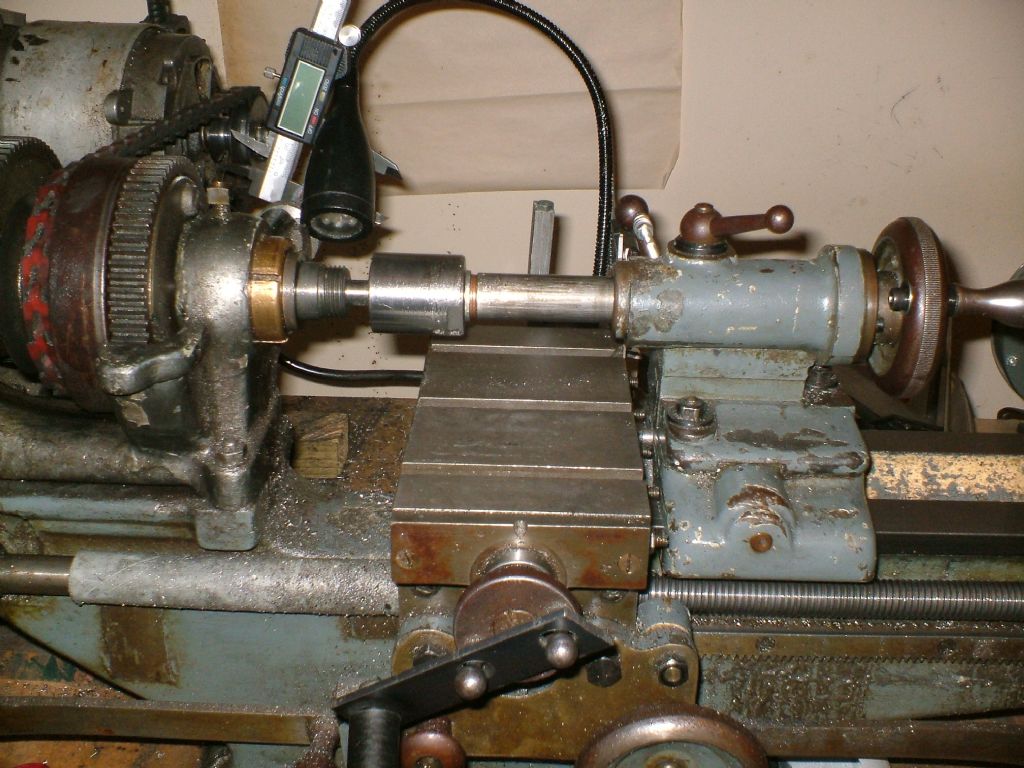My Super 7 Large Bore began to make 'crunching/ grinding' noises from the headstock area. These were random and did not seem based on loading.
After some investigation with a 'stick to the ear' I figured that the angular bearings might need attention.
Taking the bull by the horns I stripped the shaft assembly down. This is straightforward.
Chuck off.
Remove the grub screw that is under the spindle and stick a large darning needle into the hole to spear the wick.
Undo the set screw in the main gear wheel.
Drop the tension on the drive belt.
Take off the thread protecting end bush.
Loosen the set screw in the end collar and take the collar off.
Protect the end of the shaft with a block of wood and tap the shaft free.
Gently pull the shaft out of the bronze front bearing while catching everything that slides off it in the process (including the two Woodruff keys before they drop down into the works).
Undo and remove the two castellated bearing retainers in the casting with a C spanner.
Push the bearings out.
Doddle, 10 minute job.
The front bronze bearing was clean with no scratches visible – relief.
The rear bearings didn't seem that bad but there was lots of crud in them and if I spun them stuck on my fingers they did rattle a bit. Sifting through the debris in the bowl after cleaning didn't reveal any solid foreign bodies.
The original bearings were NSK type 7007A which didn't seem to exist anymore. A call to Myford got me two new bearings by IBC with the same 7007 code. Given I had it all in bits I also ordered a new wick to oil the front bronze sleeve bearing. These tend to harden over time so worth doing.
So I now had all the bits to rebuild it.
First problem was the new wick was oversize for the feed hole against the shaft. Some shaving with a scalpel trimmed it to size.
A call to Myford told me that the new bearings had to go in with the thinest side of the outer ring, outer most – i.e, the front one with this side to be facing the chuck and the rear one facing away from the chuck. This meant for the bearings I had in front of me, the inscription sides on the bearings were facing each other. Sandwiched between them is the spacer washer. This has to go in with the gap in it, at 12 o'clock where the oil can feed down into it from the oil nipple on the bearing housing.
Now have you ever tried to make sense of the re-building as described in the Myford official manual ?
I was apprehensive to say the least as it made no sense. The new bearings were very tight on the shaft which worried me but I did what I thought was right per the manual and after oiling up well, switched on. (Don't forget to put the drive belt back on the shaft …)
Not a good sound ensued. Probably worse than it was before. Really crunchy. Expletives.
Switched off and had a brew (or two). Scrap paper and pencil time. It took a while to dawn that there are two things going on.
The first thing is that all the elements on the shaft up to the 'spindle thrust shoulder' (5 in Fig 34) have to be squeezed together by the end rotating collar (4). To say you can do this with hand tightening is not practical. You need a spanner with two prongs on it to match the holes in the end collar. You can buy these from Myford but needs must and I made a crude one to do the job. Before you begin to tighten this up, loosen off the two castellated nuts sandwiching the bearings so the bearings are free to pick their own position inside the casting shell.
Once all the components are tight on the shaft you can now adjust the right hand side castellated nut to pull the front cone into the bronze bearing bush. Tighten this until the cone sticks and then back off by the specified 15 degrees so the cone is then free to move again. I fiddled with this a few times to make sure it wasn't binding in any way. Tighten up the left hand castellated bush to lock the bearings in place.
Switched on and what a difference, almost sewing machine quiet.
Given the experience I would now think that the old bearings were probably OK and had not been set up properly by the previous owner.
OK, you might say this is all obvious but I could not find anything on the Net to explain this is in simple terms and maybe I have still not fully understood but it is a different machine now.
Or have I made a fundamental mistake that someone is about to tell me about ?
Alan
Alan Wood 4.







